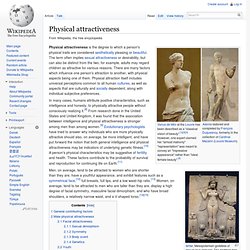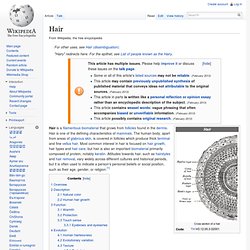

Physical attractiveness. Venus de Milo at the Louvre has been described as a "classical vision of beauty".[1][2][3] However, one expert claimed her "almost matronly" "representation" was meant to convey an "impressive appearance" rather than "ideal female beauty".[4] Ishtar, Mesopotamian goddess of sexual love and war.

The goddess has been associated with sexuality, love, and fertility.[5][6][7] Physical attractiveness is the degree to which a person's physical traits are considered aesthetically pleasing or beautiful. The term often implies sexual attractiveness or desirability, but can also be distinct from the two; for example, adults may regard children as attractive for various reasons. There are many factors which influence one person's attraction to another, with physical aspects being one of them. General contributing factors[edit] Male physical attractiveness[edit] Women, on average, tend to be more attracted to men who have a relatively narrow waist, a V-shaped torso, and broad shoulders.
Symmetry[edit] Fashion, Style & Beauty on StyleList. Hair. Hair is a filamentous biomaterial that grows from follicles found in the dermis.

Hair is one of the defining characteristics of mammals. The human body, apart from areas of glabrous skin, is covered in follicles which produce thick terminal and fine vellus hair. Most common interest in hair is focused on hair growth, hair types and hair care, but hair is also an important biomaterial primarily composed of protein, notably keratin. Attitudes towards hair, such as hairstyles and hair removal, vary widely across different cultures and historical periods, but it is often used to indicate a person's personal beliefs or social position, such as their age, gender, or religion.[1] Overview[edit] The word "hair" usually refers to two distinct structures: the part beneath the skin, called the hair follicle or when pulled from the skin, called the bulb.
Hair fibers have a structure consisting of several layers, starting from the outside: Description[edit] Strand of human hair at 200x magnification. Human hair color. Hair color is the pigmentation of hair follicles due to two types of melanin: eumelanin and pheomelanin.

Generally, if more eumelanin is present, the color of the hair is darker; if less eumelanin is present, the hair is lighter. Levels of melanin can vary over time causing a person's hair color to change, and it is possible to have hair follicles of more than one color. Particular hair colors are associated with ethnic groups. The shades of human hair color are assessed using the Fischer–Saller scale. The Fischer–Saller scale, named after Eugen Fischer and Karl Saller, is used in physical anthropology and medicine to determine the shades of hair color. Genetics and biochemistry of hair color[edit] Pheomelanin is more chemically stable than black eumelanin, but less chemically stable than brown eumelanin, so it breaks down more slowly when oxidized.
The genetics of hair colors are not yet firmly established. Natural hair colors[edit] Light chestnut brown hairWhite hair caused by albinism.